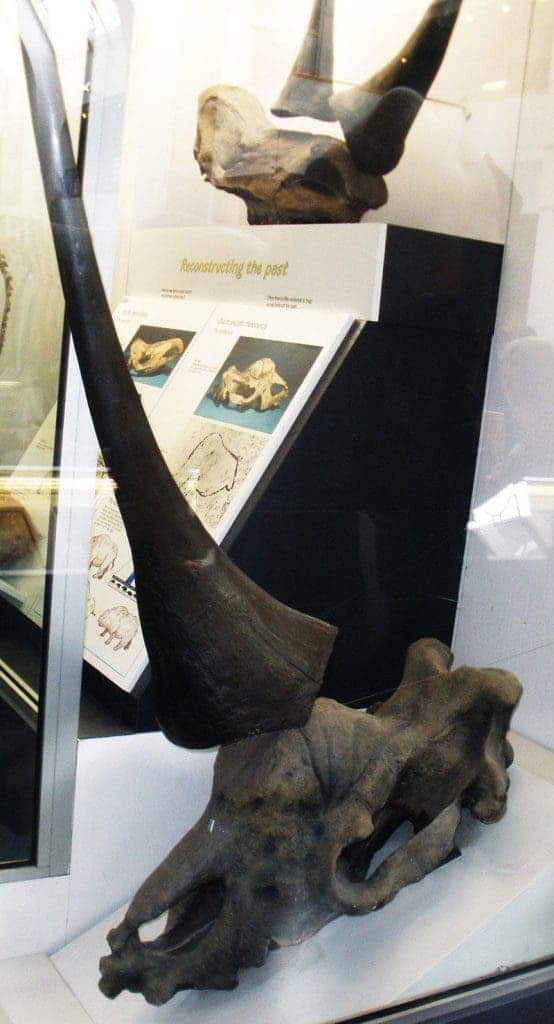The unicorn — a mythological animal that resembled a horse with a single horn on its forehead — may have been real. Russian paleontologists dated the fossil remains of a Elasmotherium sibiricum, a giant beast the size of a mammoth with a saber like horn, and found these were 35,000 years old. That places the closest resembling unicorn animal in the same place and time with humans migrating and settling Asia.

The unicorn appeared in early Mesopotamian artworks, and it also was referred to in the ancient myths of India and China. If unicorn fables were ever inspired by a living creature, scholars posited that it must have been the rhinoceros. E. sibiricum, also known as the Siberian unicorn, resembles much closer any ancient accounts of the unicorn.
Elasmotherium is an extinct genus of giant rhinoceros endemic to Eurasia during the Late Pliocene through the Pleistocene. The name literally means ‘Thin Plate Beast’. These animals were quite common in Eurasia during the last couple of million years, documented from around 2.6 million years ago to at least as late as 50,000 years ago.
The most famous of the genus, E. sibiricum, could grow up to at least 15 ft in length and a shoulder height of over 6 ft 7 in. It had a singular enormous horn on its forehead which could grow to be several feet long. That’s much bigger than that of the modern rhinoceros. It likely used it to battle male competition and predators, attract mates, but also to dig up roots, make water holes or clear snow to reach its favorite food — grass.
Some other distinct and peculiar features include high-crowned molars that never stopped growing and very long legs, at least compared to today’s rhinos. Fossils suggest that the Siberian unicorn was adapted for galloping, possessing a horse-like gait. Another notable fact is that the front feet were bigger than the hind feet. In the front, the animal had four digits and only three at the rear.

The Siberian unicorn was thought to have disappeared some 350,000 years ago, but now researchers from Tomsk State University in Siberia, Russia proved that at least some populations survived for far longer. Using the radiocarbon Accelerator Mass Spectrometry method, the researchers dated a Siberian unicorn skull found in the Pavlodar Priirtysh region of northeast Kazakhstan and found it to be 29,000 years old. The findings were reported in the American Journal of Applied Science.
“Most likely, it was a very large male of very large individual age. The dimensions of this rhino are the biggest of those described in the literature, and the proportions are typical,” Andrey Shpanski, a paleontologist at Tomsk State University.
“Most likely, the south of Western Siberia was a refúgium, where this rhino persevered the longest in comparison with the rest of its range. There is another possibility that it could migrate and dwell for a while in the more southern areas,” said Shpanski, trying to explain how this specimen was alive when populations around the world had died off far earlier.
Around this time humans were well spread throughout the Asian steps, and likely encountered the Siberian unicorn. It is then possible that the unicorn myth may have started tens of thousands of years ago, inspired by the Siberian unicorn. Here’s what famous Arabic medieval traveller Ibn Fadlan wrote about how locals describe a mythical unicorn, with startling similarities to E. sibiricum:
“Near this river (the Volga) is a vast wilderness wherein they say is an animal that is less than a camel and more like a bull in size. Its head is like the head of a camel, and its tail is like the tail of a bull, while its body is like the body of a mule, and its hooves are like the cloven hooves of a bull. In the center of its head, it has a thick round horn, which as it rises from the head of the animal gets to be thinner until it becomes like the point of a lance. The length of some of these horns is from three to five cubits (roughly 4.5-7.5 feet), and there are those that may attain to a greater or lesser length. The animal grazes on the leaves of trees, which are quite green. When it sees a horseman, it makes straight for him, and if he happens to have under him a fast horse, he is rendered safe from it with some effort. If it overtakes him, it removes him from the back of his horse with its horn, hurls him into the air, and then catches him with its horn. It continues in this manner until it kills him. It does not bother the horse in any form or manner. They seek out this animal in the forests in order to kill it. They do that by climbing the tall trees among which it is found, and with this object in mind, they assemble a number of archers with poisoned arrows. When it stands in their midst, they shoot at it until it is severely wounded and killed by them.”
It would truly be amazing if E. sibiricum was the root of the unicorn myth. Such a hypothesis, though impossible to prove, is not that far fetched.






